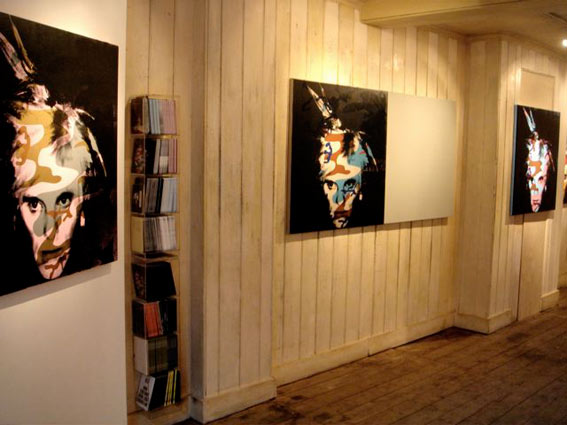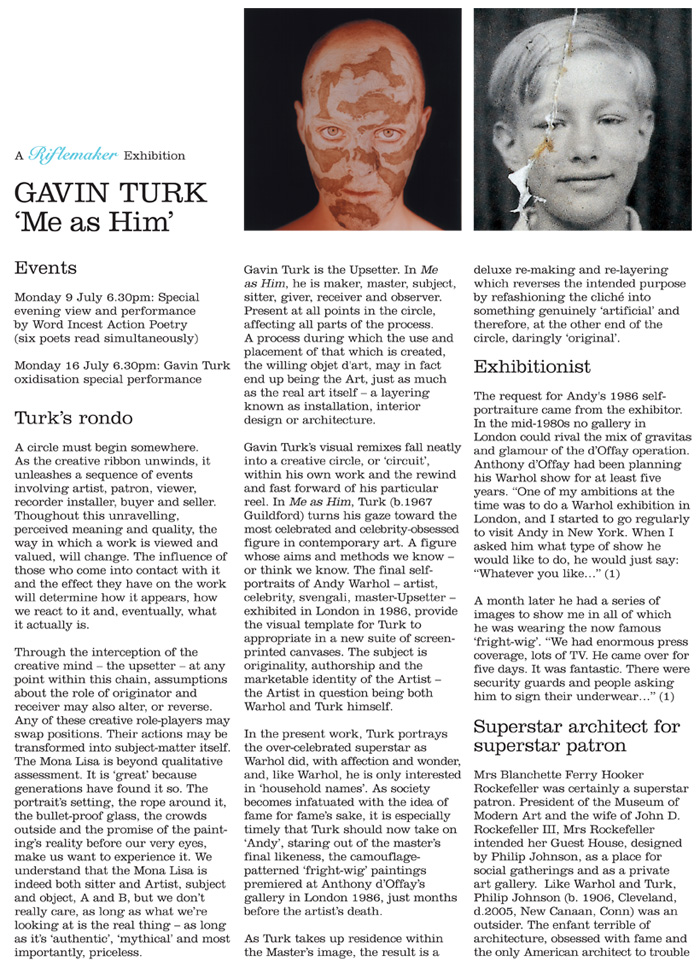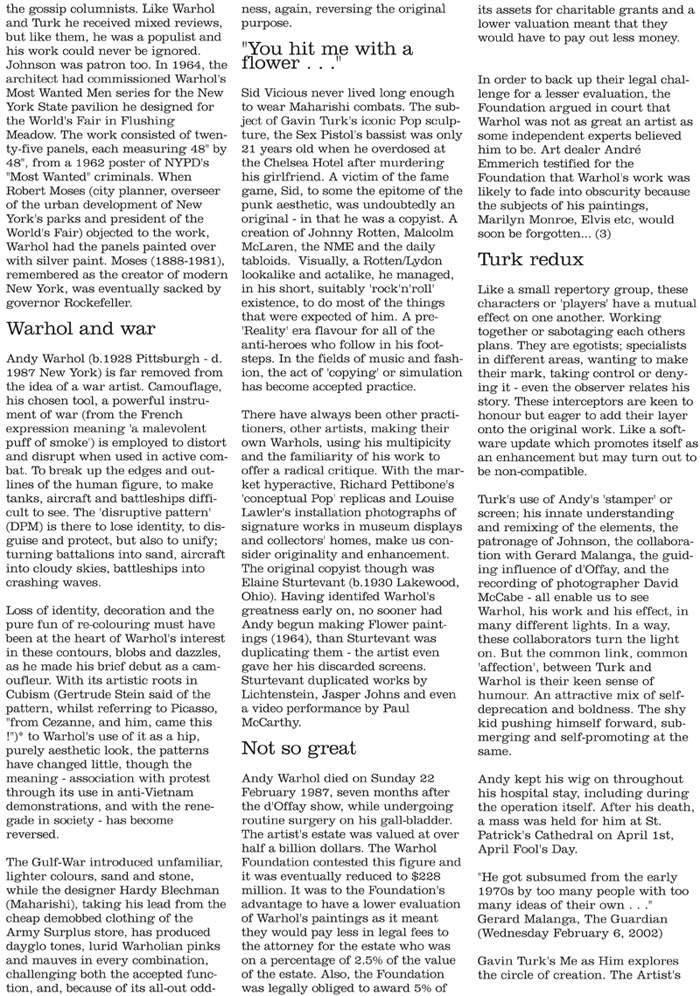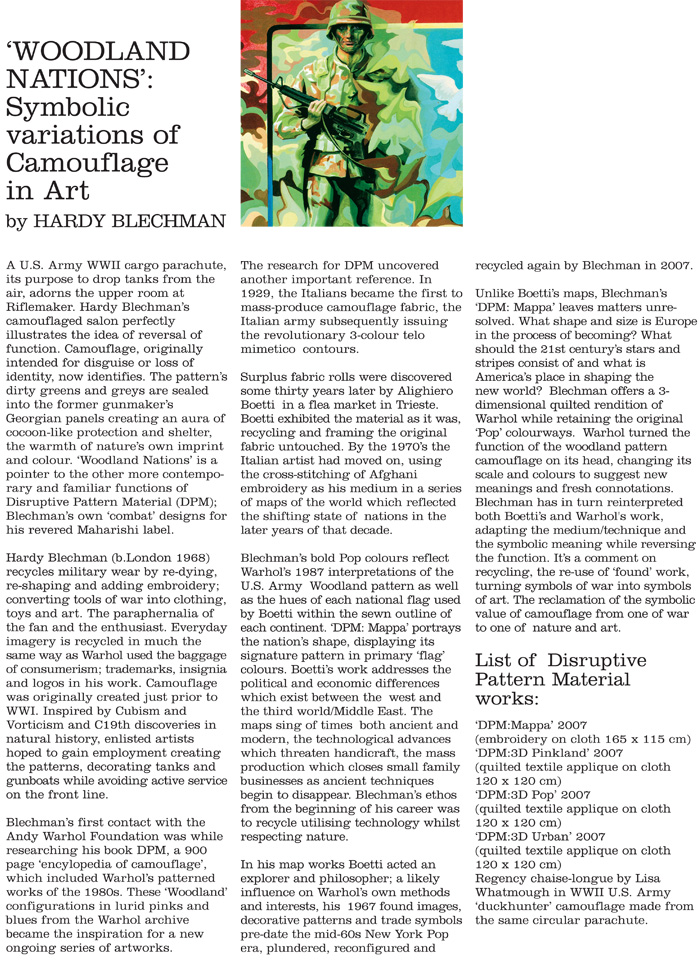GAVIN TURK
GAVIN TURK - BIOGRAPHY
Gavin Turk was born in 1967 in Guildford, England and attended the Royal College of Art in London. In 1991 Turk was denied his MA certificate from the Royal College of Art for his degree show presentation, which consisted of an empty white studio with a blue English Heritage plaque installed, which simply bore the inscription "Borough of Kensington/GAVIN TURK/Sculptor/Worked Here 1989-1991." Beginning his career paradoxically with his own demise and posthumous recognition set the tone for his subsequent work, which dealt with the cult of personality and the construction of artistic myth. In the 1990s, Turk came to prominence as one of Britain's infamous "Young British Artists" and was included in the influential Sensation exhibition in 1997.
Turk's work has been included in many seminal exhibitions including currently the groundbreaking 'POP LIFE' at Tate Modern as well as the Venice Biennale 2009, the 46th International Istanbul Biennial, Istanbul in 1999; Material Culture, Hayward Gallery, London in 1998 and Sensation: Young British Artists from the Saatchi Collection, Royal Academy of Arts, Saatchi Collection, London in 1995. Recent exhibitions have included: Gavin Turk: 'Me as Him', Riflemaker, London; Gavin Turk: The Negotiation of Purpose, GEM Museum for Contemporary Art, The Hague, The Netherlands; Gavin Turk: Last Year in Eggenburg (The Paradise Show), Schloss Eggenburg, Graz; The Golden Thread, Sculpture at Goodwood, West Sussex; Gavin Turk: et in arcadia eggo, New Art Centre Sculpture Park & Gallery, Salisbury; and Gavin Turk Oeuvre, Tate Britain Sculpture Court Display, London.
Gavin Turk lives and works in London.
Gavin Turk was born in 1967 in Guildford, England and attended the Royal College of Art in London. In 1991 Turk was denied his MA certificate from the Royal College of Art for his degree show presentation, which consisted of an empty white studio with a blue English Heritage plaque installed, which simply bore the inscription "Borough of Kensington/GAVIN TURK/Sculptor/Worked Here 1989-1991." Beginning his career paradoxically with his own demise and posthumous recognition set the tone for his subsequent work, which dealt with the cult of personality and the construction of artistic myth. In the 1990s, Turk came to prominence as one of Britain's infamous "Young British Artists" and was included in the influential Sensation exhibition in 1997.
Turk's work has been included in many seminal exhibitions including currently the groundbreaking 'POP LIFE' at Tate Modern as well as the Venice Biennale 2009, the 46th International Istanbul Biennial, Istanbul in 1999; Material Culture, Hayward Gallery, London in 1998 and Sensation: Young British Artists from the Saatchi Collection, Royal Academy of Arts, Saatchi Collection, London in 1995. Recent exhibitions have included: Gavin Turk: 'Me as Him', Riflemaker, London; Gavin Turk: The Negotiation of Purpose, GEM Museum for Contemporary Art, The Hague, The Netherlands; Gavin Turk: Last Year in Eggenburg (The Paradise Show), Schloss Eggenburg, Graz; The Golden Thread, Sculpture at Goodwood, West Sussex; Gavin Turk: et in arcadia eggo, New Art Centre Sculpture Park & Gallery, Salisbury; and Gavin Turk Oeuvre, Tate Britain Sculpture Court Display, London.
Gavin Turk lives and works in London.
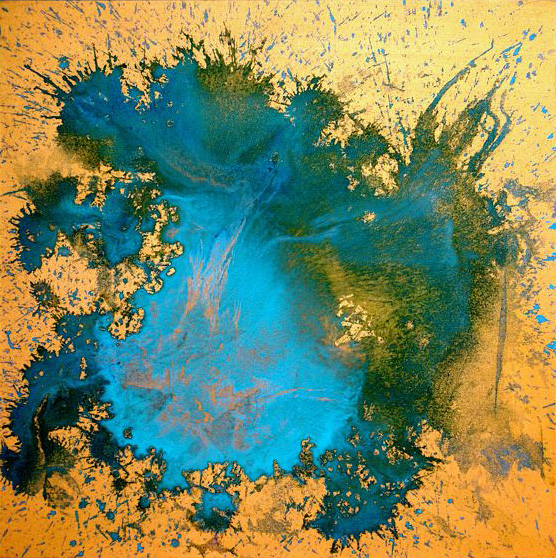
OXIDISATION PAINTINGS
100 x 100 cms,
oxidised copper-prepared canvas
conservation-level museum acrylic box
and framed support (2007)
Exhibited Sotheby’s London
The oxidisation paintings were instigated by a performance at Riflemaker on July 16th as part of Turk's 'Me as Him' exhibition, the 'him' in question being Andy Warhol. Having prepared the canvases beforehand, Turk oxidised the works at his studio in Hackney. The four resulting canvases were then exhibited in a special exhibition at Sotheby's, Bond Street during Frieze Week.
DOUBLE FRIGHT-WIG CANVAS
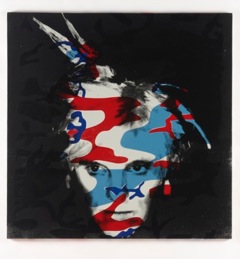
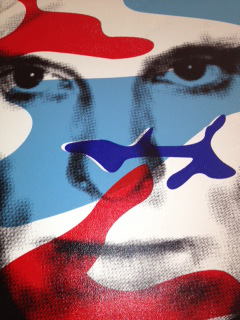
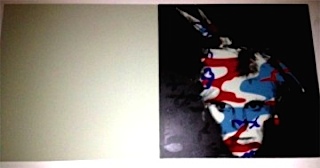
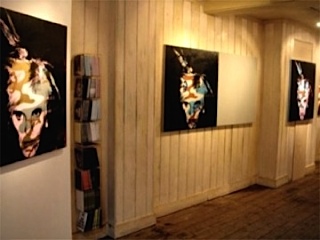
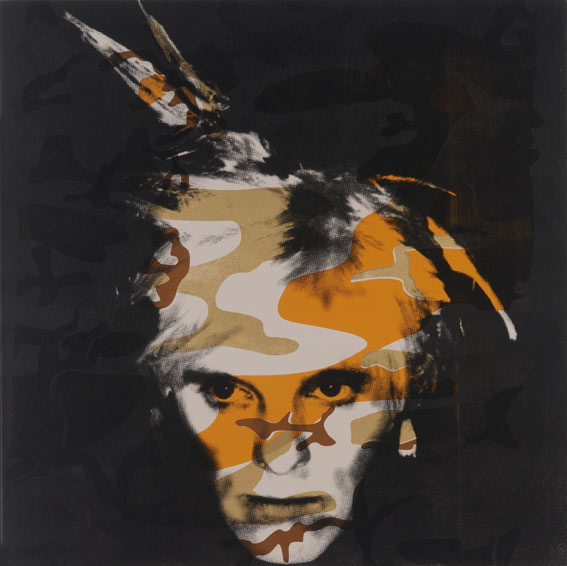
Gavin Turk
Camouflage Fright Wig Gold and Taupe
2007
Silkscreen ink on acrylic paint on canvas
39 3/8 x 39 3/8 in. (100 x 100 cm)
Camouflage Fright Wig Gold and Taupe
2007
Silkscreen ink on acrylic paint on canvas
39 3/8 x 39 3/8 in. (100 x 100 cm)
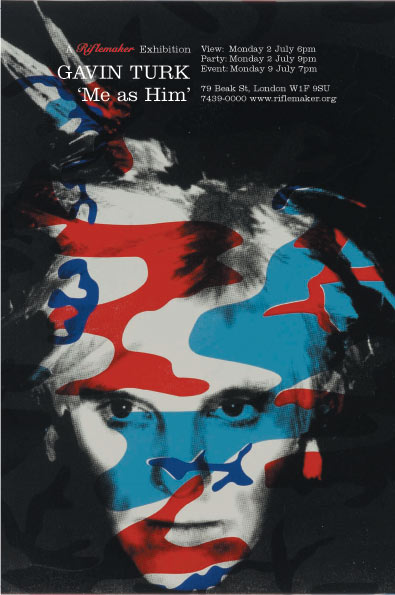
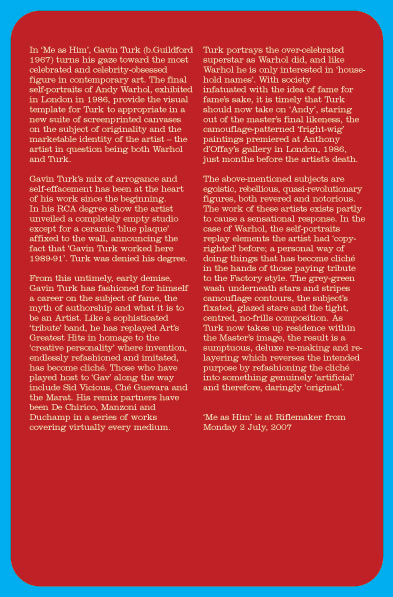
Gavin Turk: 'Me as Him'
Gavin Turk: 'Me as Him'
Opening: Monday 2 July 6pm
Expo: Tuesday 3 July 10-6pm
Event
Monday 16 July
Gavin Turk special live oxidisation performance
Live Oxidization 'Piss' Painting
Throughout history artists have used their own body fluids, urine particularly, to make work. Gavin Turk will pay homage to Warhol paying homage to Jackson Pollock in this very special live oxidization evening. Picasso was known to urinate on his 'found' sculptures at Vallauris, Pollock would urinate on paintings which were on their way to dealers he didn't like.
Turk will make links back and forwards to art history, a complement to the current exhibition which along with the Hardy Blechman camouflage installation will be open and on view from 6 until 9pm.
This is a Riflemaker free event so please come early.
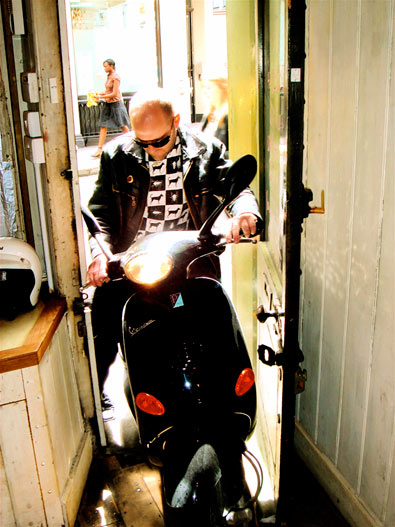
A circle must begin somewhere. As the creative ribbon unwinds, it sets off a sequence of events involving artist, patron, viewer, recorder and installer. Thoughout this unravelling, perceived meaning and quality, the way in which a work is viewed and valued, will change. The influence of those who come into contact with it and the effect they have on the work will determine how it appears, how we react to it and, eventually, what it actually is.
Through the interception of the creative mind - the upsetter - at any point within this chain, assumptions about the role of originator and receiver may also alter, or reverse. Any of these creative role-players may swap positions. Their actions may be transformed into subject-matter itself. The Mona Lisa is beyond qualitative assessment. It is 'great' because generations have found it so. The portrait's setting, the rope around it, the bullet-proof glass, the crowds outside and the promise of the painting's reality before our very eyes, make us want to experience it. We understand that the Mona Lisa is indeed both sitter and Artist, subject and object, A and B, but we don't really care, as long as what we're looking at is the real thing - as long as it's 'authentic', 'mythical' and most importantly, priceless.
Authorship and signature is all. The back of the painting as valuable, as viable, as the front; obverse and reverse, in the language of coinage. Who did it. Did what exactly ? Created the work... or the myth ? What you see is what you get at entry point, but it may not be what you get after time. People don't fire 'blanks' anymore. Everyone, not just the Artist, wants to have an effect, invent/re-invent, promote, distort, sabotage. Thus, time's ribbon will change both the perception and result of the fireball in the event chain - and it will change us.
Gavin Turk is the Upsetter. In Me as Him, he is maker, master, subject, sitter, giver, receiver and observer. Present at all points in the circle, affecting all parts of the process. A process during which the use and placement of that which is created, the willing objet d'art, may in fact end up being the Art, just as much as the real art itself - a layering known as installation, interior design or architecture.
But the Artist is not the only one who receives 'the spark'. The Receiver may yet steal the badge Artist, for it is he who notices and understands, makes fire, acts upon that flicker of intent; that gold thread which needs reception, perception and enhancement to make it live - to make it 'really real', or in Turk's case, really and truly artificial. The Receiver gets an idea noticed. He brings it to life so that other creators and noticers may act upon and benefit from it. In this life, this day and age, in and out of context, in this 'mash'; perception, placement and enhancement really are everything.
Gavin Turk's visual remixes fall neatly into a creative circle, or 'circuit', within his own work and the rewind and fast forward of his particular reel. In Me as Him, Turk (b.1967 Guildford) turns his gaze toward the most celebrated and celebrity-obsessed figure in contemporary art. A figure whose aims and methods we know - or think we know. The final self-portraits of Andy Warhol - artist, celebrity, svengali, master-Upsetter - exhibited in London in 1986, provide the visual template for Turk to appropriate in a new suite of screenprinted canvases. The subject is originality, authorship and the marketable identity of the Artist - the Artist in question being both Warhol and Turk himself.
Gavin Turk's rough mix of arrogance and self-effacement has been at the heart of his work since the beginning. In his RCA degree show the artist unveiled a completely empty studio except for a ceramic blue-plaque affixed to the wall, announcing the fact that 'Gavin Turk worked here 1989-91'. Turk was denied his degree. The Artist ignited his best, most personal spark. Hardly anyone noticed.
From this untimely, early demise, Turk has fashioned for himself a career on the subject of fame, the myth of authorship and what it is to be an Artist. Like a sophisticated 'tribute' band, he has replayed Art's Greatest Hits in homage to the 'creative personality' where invention, endlessly refashioned and imitated, becomes cliché. Those who have played host to 'Gav' along the way include Sid Vicious (inhabiting Warhol's Elvis pose), Ché Guevara and David's Marat. His remix partners have been De Chirico, Klein, Manzoni and Duchamp in a series of works covering virtually every medium.
In the present work, Turk portrays the over-celebrated superstar as Warhol did, with affection and wonder, and, like Warhol, he is only interested in 'household names'. As society becomes infatuated with the idea of fame for fame's sake, it is especially timely that Turk should now take on 'Andy', staring out of the master's final likeness, the camouflage-patterned 'fright-wig' paintings premiered at Anthony d'Offay's gallery in London 1986, just months before the artist's death.
The above-mentioned are all egoistic, rebellious, quasi-revolutionary figures, both revered and notorious. The work of these artists exists partly to cause a sensational response. In the case of Warhol, the self-portraits replay elements the artist had 'copyrighted' before; a personal way of doing things that has since become cliché in the hands of those paying tribute to the Factory style. The grey-green wash underneath stars and stripes red and blue. The fascination with camouflage, an illusion and rendering developed for the purpose of distortion and loss of identity, rather than the vagaries of fashion and 'being noticed' - the way in which the pattern is used today. Lastly, the subject's fixated stare and the tight, no-frills composition. The very idea of self-portaiture suggests a 'stamper' approach; passport fotos, postage-stamps, mugshots and banknotes. ID itself is literally a 'pose', the creation of a personal uniqueness nowadays jargonised as 'branding'. Just as Warhol utlised his hooped Picasso shirt, his shades, his wig, his ever present camera to make a instant easy-to-use cartoon out of his own complex reality.
As Turk takes up residence within the Master's image, the result is a deluxe re-making and re-layering which reverses the intended purpose by refashioning the cliché into something genuinely 'artificial' and therefore, at the other end of the circle, daringly 'original'.
The request for Andy's 1986 self-portraiture came from the exhibitor. In the mid-1980s no gallery in London could rival the mix of gravitas and glamour of the d'Offay operation. Anthony d'Offay had been planning his Warhol show for at least five years. "One of my ambitions at the time was to do a Warhol exhibition in London, and I started to go regularly to visit Andy in New York. When I asked him what type of show he would like to do, he would just say: "Whatever you like . . ." (1)
"We visited a collector friend who had a powerful red portrait of Beuys by Andy hanging in his house. As I looked at the painting I realised two things; first that without question Warhol was the greatest portrait painter of the 20th century, and secondly that it was many years since he had made an iconic self-portrait.
"I visited him in New York and suggested a series of new self-portraits. A month later he had a series of images to show me in all of which he was wearing the now famous 'fright-wig'. One had not only a demonic aspect but reminded me more of a death-mask. I felt it was tempting fate to choose this image so I settled instead on a self-portrait with an hypnotic intensity. We agreed on the number of paintings and that some would have camouflage. When I returned to New York some weeks later the paintings were complete. The only problem was that Warhol had painted the demonic 'Hammer House of Horror' image rather than the one we had chosen. I remonstrated with him and reminded him of our agreement. Without demur he made all the pictures again but with the image we had first selected. So between us we brought two great series of self-portraits into the world. (2)
"We had enormous press coverage, lots of TV. He came over for five days. It was fantastic. There were security guards and people asking him to sign their underwear . . ." (1)
Mrs Blanchette Ferry Hooker Rockefeller was certainly a superstar patron. President of the Museum of Modern Art and the wife of John D. Rockefeller III, Mrs Rockefeller intended her Guest House, designed by Philip Johnson, as a place for social gatherings and as a private art gallery.
It is fitting that the most recorded photograph of a Warhol 'fright-wig' should be that taken in the Guest House, a narrow symmetrical glass construction just one room wide, wedged between two much taller townhouses at East 52nd St in midtown Manhattan. A superstar canvas in a superstar house by a superstar architect. Like a staircase of fame, Gavin Turk's remakings complete a cycle moving outwards and inwards simultaneously. But the line or 'ripple' actually begins with Johnson. Andy's robin-red ink radiates though the reflective glass surfaces as the screenprinted canvas hangs majestically in the residence which has become a permanent fixture in coffee-table books on modernity and the International Style.
Like Warhol and Turk, Philip Johnson (b. 1906, Cleveland, d.2005, New Canaan, Conn) was an outsider. The enfant terrible of architecture, obsessed with fame and the only American architect to trouble the gossip columnists. Like Warhol and Turk he received mixed reviews, but like them, he was a populist and his work could never be ignored.
Johnson was patron too. In 1964, the architect had commissioned Warhol's Most Wanted Men series for the New York State pavilion he designed for the World's Fair in Flushing Meadow. The work consisted of twenty-five panels, each measuring 48" by 48", from a 1962 poster of NYPD's "Most Wanted" criminals.
When Robert Moses (city planner, overseer of the urban development of New York's parks and president of the World's Fair) objected to the work, Warhol had the panels painted over with silver paint. The canvas versions were exhibited in 1967 at the Galerie Ileana Sonnabend in Paris. In 1968, the exhibition travelled to London and was shown at the Rowan Gallery. Moses (1888-1981), remembered as the creator of modern New York, was eventually sacked by governor Rockefeller.
Commissioned in 1948, the Guest House had a distinguished history. The Rockefellers donated the house to MoMA in 1955. It was then bought in 1964 by Robert C. Leonhardt. For a time after Leonhardt's death in 1971, Johnson himself lived in the house as a tenant ('71 - '79). Robert Symes, followed by Ronald S. Lauder were the next owners, until Anthony d'Offay purchased it. It was later sold at auction by Christie's. The house - at least as well known as its celebrated keepers - was given landmark status by the Landmarks Preservation Commission in December 2000.
In the iconic photograph, the Warhol self-portrait sits perfectly with the architect's lyrical symmetry. The swathes of red and black contrasting with the opaque interior and clean lines of Johnson's mid-career masterpiece. Johnson is pictured at his office by Arnold Newman, who specialized in photographing his subjects enhanced by their work environment; Leonard Bernstein staring out from empty orchestra seats, Stravinsky with Steinway, Pollock with industrial paint pots, as if they would feel abandoned or unidentifiable without the tools and props of their trade. Newman's own trademark self-portrait finds him amidst banks of flashbulbs and reflectors.
Philip Johnson ate lunch daily at a special table in the corner of the Grill Room of the Four Seasons restaurant. In the evenings, he was to be seen with Andy at Studio 54, Halston's, or openings at MoMA or the Met. Johnson collected art from an early age and had purchased a pair of Paul Klees directly from the artist. At age twenty-six, he became the director of the Museum of Modern Art's new Architecture & Design department and co-curated the influential exhibition The International Style which introduced the American public to European Modernism and the ideas of Le Corbusier and Mies van der Rohe. As a collector, he came to specialize in contemporary work, especially the great figures of the Pop era - Lichtenstein, Warhol, Jasper Johns and Frank Stella, whose works decorated the walls of his office in the Seagram Building, the skyscraper he designed with Mies, its principal architect.
Andy Warhol (b.1928 Pittsburgh - d. 1987 New York) is far removed from the idea of a war artist. Camouflage, his chosen tool, a powerful instrument of war (from the French expression meaning 'a malevolent puff of smoke') is employed to distort and disrupt when used in active combat. To break up the edges and outlines of the human figure, to make tanks, aircraft and battleships difficult to see. The 'disruptive pattern' (DPM) is there to lose identity, to disguise and protect, but also to unify; turning battalions into sand, aircraft into cloudy skies, battleships into crashing waves.
Loss of identity, decoration and the pure fun of re-colouring must have been at the heart of Warhol's interest in these contours, blobs and dazzles, as he made his brief debut as a camoufleur. With its artistic roots in Cubism (Gertrude Stein said of the pattern, whilst referring to Picasso, "from Cezanne, and him, came this !")* to Warhol's use of it as a hip, purely aesthetic look, the patterns have changed little, though the meaning - association with protest through its use in anti-Vietnam demonstrations, and with the renegade in society - has become reversed. The acceptance of animalistic camouflage as everyday apparel through its association with the rebel; de Niro in Taxi Driver, the Unabomber, IRA and terrorist splinter groups, confirms its place as an enduring fashion-statement over several decades.
The Gulf-War introduced unfamiliar, lighter colours, sand and stone, while the designer Hardy Blechman (Maharishi), taking his lead from the cheap demobbed clothing of the Army Surplus store, has produced dayglo tones, lurid Warholian pinks and mauves in every combination, challenging both the accepted function, and, because of its all-out oddness, again, reversing the original purpose. Maharishi 'combat' trousers listed as 'Genuine Faulty' are sought-after items on ebay. US designer Stephen Sprouse produced men's suits and ladies evening wear using the Warhol pattern, having gained permission from Andy before the artist's death.
But the hard-up student or street poseur does not don the contours in order to lose identity or to blend in; he wears it to stand out, and the crazier the crazee-colour the better. Warhol pre-empted this decades earlier, with his full-on 'bad' mixtures of pink and yellow, blood-orange and red; challenging accepted taste and accepted colour contrasts and co-ordination. Why not invest in a camouflaged case for your iPod in cherry-pink and maroon, a camouflaged tea-cup in grunge-brown and olive-grey, a toilet-seat in red, white and blue ? Even the Union Jack has been camouflaged, even the Queen has been camouflaged. The 'trademark' itself having been disguised, the 'brand' commandeered, reconfigured . . . enhanced, 'blended in'.
Sid Vicious never lived long enough to wear Maharishi combats. The subject of Gavin Turk's iconic Pop sculpture, the Sex Pistol's bassist was only 21 years old when he overdosed at the Chelsea Hotel after murdering his girlfriend. A victim of the fame game, Sid, to some the epitome of the punk aesthetic, was undoubtedly an original - in that he was a copyist. A creation of Johnny Rotten, Malcolm McLaren, the NME and the daily tabloids.
Visually, a Rotten/Lydon lookalike and actalike, he managed, in his short, suitably 'rock'n'roll' existence, to do most of the things that were expected of him. A pre-'Reality' era flavour for all of the anti-heroes who follow in his footsteps. In the fields of music and fashion, the act of 'copying' or simulation has become accepted practice. We buy from designer labels called Fake London, the unreleased bootleg recording is more sought after than the official release. Every luxury consumer item, from ragged Levi's to nicely weathered Mies chairs, is promoted as either a copy, a 'perfect' fake, or the real, 'real' thing itself; yes . . . certified, prime Vintage.
There have always been other practitioners, other artists, making their own Warhols, using his multipicity and the familiarity of his work to offer a radical critique. With the market hyperactive, Richard Pettibone's 'conceptual Pop' replicas and Louise Lawler's installation photographs of signature works in museum displays and collectors' homes, make us consider originality and enhancement. The original copyist though was Elaine Sturtevant (b.1930 Lakewood, Ohio). Having identifed Warhol's greatness early on, no sooner had Andy begun making Flower paintings (1964), than Sturtevant was duplicating them - the artist even gave her his discarded screens. Sturtevant duplicated works by Lichtenstein, Jasper Johns and even a video performance by Paul McCarthy. All this extra product fills in the gaps - if Andy left any. It makes more product, pads the myth, buffs up the market and, of course, makes both the copies and the originals more valuable, more 'unique'.
Andy Warhol died on Sunday 22 February 1987, seven months after the d'Offay show, while undergoing routine surgery on his gall-bladder. The artist's estate was valued at over half a billion dollars. The Warhol Foundation contested this figure and it was eventually reduced to 8 million. It was to the Foundation's advantage to have a lower evaluation of Warhol's paintings as it meant they would pay less in legal fees to the attorney for the estate who was on a percentage of 2.5% of the value of the estate. Also, the Foundation was legally obliged to award 5% of its assets for charitable grants and a lower valuation meant that they would have to pay out less money.
In order to back up their legal challenge for a lesser evaluation, the Foundation argued in court that Warhol was not as great an artist as some independent experts believed him to be. Art dealer André Emmerich testified for the Foundation that Warhol's work was likely to fade into obscurity because the subjects of his paintings, Marilyn Monroe, Elvis etc, would soon be forgotten... (3)
Andy met his assistant and facilitator Gerard Malanga on June 9, 1963. The student had been suggested by Charles Henri Ford to help Andy with his screenprinting. Malanga, a dancer on Alan Freed's Big Beat television show, was out of work due to the show having been closed down when Freed was busted in a payola scandal.
The two came together at a poetry reading at the New School. Malanga (b.1943, New York), who had spent the summer of 1962 silkscreening neckties in the garment district, began working for Andy for the state minimum wage of .25 an hour. His poetry had appeared in Paris Review, Partisan Review, Poetry and The New Yorker prior to meeting Warhol. After working for Warhol for almost a year, he decided not to go back to college for his final term. According to Gerard, in his book Archiving Warhol, the first painting he silkscreened for his boss was a 40" x 40" silver Elizabeth Taylor (Silver Liz). In 1985, Malanga was appointed by Henry J. Stern, Commissioner of NYC Department of Parks & Recreation, as that agency's first photo archivist, in charge of the Robert Moses historic negative collection, which he single-handedly conserved and catalogued.
As Warhol's contoured screens are overlaid onto Gavin Turk's impenetrable expression, exactly where the curves fall and their colour alters that expression. As every portrait painter knows, the merest flicker or shadow which trespasses across the line of the mouth changes the psychological demeanour and the perceived intellectual capability and intention of the subject, injecting a coyness, slyness or arrogance, an innocence or malevolence, that wasn't present before. A further reason why the badge of camouflage is chosen by the outsider, the campaigner, the martyr. This often negligible but noticeable change is the main figurative action and emotional result of Turk's random placement of DPM onto his self-portrait, clouding and masking the anaemic demigod as he emerges Kurtz-like from the darkness.
British photographer David McCabe was contacted in early 1964 by Andy Warhol after the artist had seen a layout by the young photographer in the pages of Mademoiselle. McCabe (b.1940 Leicester) was assigned the task of documenting the artist's life for a whole year. Some 2500 photographs later, McCabe had succeeded in capturing Andy at art openings, psychedelic happenings, drinking his morning coffee at the diner around the corner and working on the first Flower paintings in his studio with Malanga. McCabe photographed Warhol in Philip Johnson's New Canaan glass house when Andy visited in the winter of 1964/5 and briefly appeared as a photographer in Warhol's film Kitchen.
1964-'65 was a crucial year in Warhol's career. Living by night and sleeping by day on Seconal or 'reds', this was the time when the perception of him and who he was, his 'creative image', started playing a major role in the construction of his legend. McCabe's photographs, never used by Warhol, appeared some forty years later in the book A Year In The Life of Andy Warhol (Phaidon 2003). Unseen and unfamiliar, they constitute an astonishing documentation of Warhol's life during that inventive and productive period.
By chance, I found myself a participant in the event chain. Invited to the d'Offay opening by Andy's assistant Anthony Fawcett, I occupied the role of mere observer. The self-portraits, and the Artist himself, appeared very differently to me that day to how I view them now. The paintings seemed cold, stark, knocked-off and, for some reason, atypical; the work of a dimmed intelligence, a machine with the power turned off. Today I see them as warm, sun bright, electrified; truly magical, quintessentially typical works. At the dinner afterwards, the hosts made sure that every guest got five minutes to sit next to Andy and 'chat', as they described it. When my time came, Warhol was indeed chatty, as he admired my shirt, discussed the menu, regaled me with stories about the Factory (yes really) . . . and spent a few moments drawing on a greetings card for my sister's birthday.
Like a small repertory group, these characters or 'players' have a mutual effect on one another. Working together or sabotaging each others plans. They are egotists; specialists in different areas, wanting to make their mark, taking control or denying it - even the observer relates his story. These interceptors are keen to honour but eager to add their layer onto the original work. Like a software update which promotes itself as an enhancement but may turn out to be non-compatible.
Turk's use of Andy's 'stamper' or screen; his innate understanding and remixing of the elements, the patronage of Johnson, the collaboration with Malanga, the guiding influence of d'Offay, and the recording of McCabe - all enable us to see Warhol, his work and his effect, in many different lights. In a way, these collaborators turn the light on. But the common link, common 'affection', between Turk and Warhol is their keen sense of humour. An attractive mix of self-deprecation and boldness. The shy kid pushing himself forward, submerging and self-promoting at the same.
Andy kept his wig on throughout his hospital stay, including during the operation itself. After his death, a mass was held for him at St. Patrick's Cathedral on April 1st, April Fool's Day.
"He got subsumed from the early 1970s by too many people with too many ideas of their own . . ."
Gerard Malanga, The Guardian (Wednesday February 6, 2002)
Gavin Turk's Me as Him explores the circle of creation. The Artist's journey from A to B and back. It references the truly immortal, celebrates the sponsor and the saboteur, reverses the original - opens at Riflemaker Monday 2 July 2007.
Tot Taylor
Sources:
* 'Sphere' Magazine, 1918, Imperial War Museum, London.
(1) The Guardian, 4 February 2002, interview with Leo Hickman
(2) Letter from Anthony d'Offay to Deitmar Elger, Feb 17, 2004
(3) www.warholstars.com
A Riflemaker exhibition curated by Virginia Damtsa & Tot Taylor. Special thanks to Gerard Malanga, David McCabe and Anthony d'Offay.
A Riflemaker book 'Me as Him' is published to co-incide with the exhibition (see info)
Book designed by Julian Balme at Vegas. 'Turk's Rondo' text by Tot Taylor.
The Rockefeller Guest House was designed by Philip Johnson (in association with Landis Gore and Frederick C. Genz, Architects) 1949-1950. Philip Johnson was also the architect of the Seagram Building and the first extension of MoMA. He was the first person to coin the phrase 'The International Style'. Following his death in 2005 the New Canaan Glass House was opened to the public, www.philipjohnsonglasshouse.org
We are deeply indebted to:
Jay Jopling/White Cube, Irene Bradbury, Kristina Lindell, Miho Umiho, Lucy Wilson at Theresa Simon Communications, Nat Foreman at Phaidon, Redferns, ArcAid, Getty Images, Rex Features.
All Gavin Turk images courtesy Jay Jopling/White Cube, London
Gavin Turk: 'Collected Works 1989–93' S. Bill and A. Wilson: (London, 1994)
Gavin Turk: 'Collected Works 1994–98' J. Compston and A. Farquharson: (London, 1998)
Sensation: Exhibition catalogue, (Royal Academy, London 1997)
Andy Warhol: 'Warhol Self-Portraits' ed.Dietmar Elger (Hatje Cantz 2004)
David Dalton & David McCabe, 'A Day In The Life Of Andy Warhol' (Phaidon 2003)
Andy Warhol: 'The Philosophy of Andy Warhol - From A to B and back again' (San Diego, 1977)
Philip Johnson: 'The Architect In His Own Words', Hilary Lewis and John O'Connor (Rizzoli 1994)
Philip Johnson: 'Life and Work', Franz Schulze (University of Chicago Press 1996)
The Power Broker: Robert Moses and the Fall of New York, Robert A. Caro (Alfred A. Knopf 1974)
Gerard Malanga: 'Archiving Warhol' (Creation Books, London 2002)
Gerard Malanga: 'Up from the Archives' (Sub Rosa CD SR170) 1999. www.gerardmalanga.com
Disprutive Pattern Material: An Encyclopedia of Camouflage', Hardy Blechman (Firefly Books 2003)
False Colors: Art, Design and Modern Camouflage, Roy R. Behrens’ (Bobolink Books, 2002)
Gavin Turk: 'Me as Him'
Opening: Monday 2 July 6pm
Expo: Tuesday 3 July 10-6pm
Event
Monday 16 July
Gavin Turk special live oxidisation performance
Live Oxidization 'Piss' Painting
Throughout history artists have used their own body fluids, urine particularly, to make work. Gavin Turk will pay homage to Warhol paying homage to Jackson Pollock in this very special live oxidization evening. Picasso was known to urinate on his 'found' sculptures at Vallauris, Pollock would urinate on paintings which were on their way to dealers he didn't like.
Turk will make links back and forwards to art history, a complement to the current exhibition which along with the Hardy Blechman camouflage installation will be open and on view from 6 until 9pm.
This is a Riflemaker free event so please come early.

Gavin Turk arrives at Riflemaker, Tuesday 3 July 2007
Turk's rondo
A circle must begin somewhere. As the creative ribbon unwinds, it sets off a sequence of events involving artist, patron, viewer, recorder and installer. Thoughout this unravelling, perceived meaning and quality, the way in which a work is viewed and valued, will change. The influence of those who come into contact with it and the effect they have on the work will determine how it appears, how we react to it and, eventually, what it actually is.
Through the interception of the creative mind - the upsetter - at any point within this chain, assumptions about the role of originator and receiver may also alter, or reverse. Any of these creative role-players may swap positions. Their actions may be transformed into subject-matter itself. The Mona Lisa is beyond qualitative assessment. It is 'great' because generations have found it so. The portrait's setting, the rope around it, the bullet-proof glass, the crowds outside and the promise of the painting's reality before our very eyes, make us want to experience it. We understand that the Mona Lisa is indeed both sitter and Artist, subject and object, A and B, but we don't really care, as long as what we're looking at is the real thing - as long as it's 'authentic', 'mythical' and most importantly, priceless.
Authorship and signature is all. The back of the painting as valuable, as viable, as the front; obverse and reverse, in the language of coinage. Who did it. Did what exactly ? Created the work... or the myth ? What you see is what you get at entry point, but it may not be what you get after time. People don't fire 'blanks' anymore. Everyone, not just the Artist, wants to have an effect, invent/re-invent, promote, distort, sabotage. Thus, time's ribbon will change both the perception and result of the fireball in the event chain - and it will change us.
Gavin Turk is the Upsetter. In Me as Him, he is maker, master, subject, sitter, giver, receiver and observer. Present at all points in the circle, affecting all parts of the process. A process during which the use and placement of that which is created, the willing objet d'art, may in fact end up being the Art, just as much as the real art itself - a layering known as installation, interior design or architecture.
But the Artist is not the only one who receives 'the spark'. The Receiver may yet steal the badge Artist, for it is he who notices and understands, makes fire, acts upon that flicker of intent; that gold thread which needs reception, perception and enhancement to make it live - to make it 'really real', or in Turk's case, really and truly artificial. The Receiver gets an idea noticed. He brings it to life so that other creators and noticers may act upon and benefit from it. In this life, this day and age, in and out of context, in this 'mash'; perception, placement and enhancement really are everything.
Gavin Turk's visual remixes fall neatly into a creative circle, or 'circuit', within his own work and the rewind and fast forward of his particular reel. In Me as Him, Turk (b.1967 Guildford) turns his gaze toward the most celebrated and celebrity-obsessed figure in contemporary art. A figure whose aims and methods we know - or think we know. The final self-portraits of Andy Warhol - artist, celebrity, svengali, master-Upsetter - exhibited in London in 1986, provide the visual template for Turk to appropriate in a new suite of screenprinted canvases. The subject is originality, authorship and the marketable identity of the Artist - the Artist in question being both Warhol and Turk himself.
Gavin Turk's rough mix of arrogance and self-effacement has been at the heart of his work since the beginning. In his RCA degree show the artist unveiled a completely empty studio except for a ceramic blue-plaque affixed to the wall, announcing the fact that 'Gavin Turk worked here 1989-91'. Turk was denied his degree. The Artist ignited his best, most personal spark. Hardly anyone noticed.
From this untimely, early demise, Turk has fashioned for himself a career on the subject of fame, the myth of authorship and what it is to be an Artist. Like a sophisticated 'tribute' band, he has replayed Art's Greatest Hits in homage to the 'creative personality' where invention, endlessly refashioned and imitated, becomes cliché. Those who have played host to 'Gav' along the way include Sid Vicious (inhabiting Warhol's Elvis pose), Ché Guevara and David's Marat. His remix partners have been De Chirico, Klein, Manzoni and Duchamp in a series of works covering virtually every medium.
In the present work, Turk portrays the over-celebrated superstar as Warhol did, with affection and wonder, and, like Warhol, he is only interested in 'household names'. As society becomes infatuated with the idea of fame for fame's sake, it is especially timely that Turk should now take on 'Andy', staring out of the master's final likeness, the camouflage-patterned 'fright-wig' paintings premiered at Anthony d'Offay's gallery in London 1986, just months before the artist's death.
The above-mentioned are all egoistic, rebellious, quasi-revolutionary figures, both revered and notorious. The work of these artists exists partly to cause a sensational response. In the case of Warhol, the self-portraits replay elements the artist had 'copyrighted' before; a personal way of doing things that has since become cliché in the hands of those paying tribute to the Factory style. The grey-green wash underneath stars and stripes red and blue. The fascination with camouflage, an illusion and rendering developed for the purpose of distortion and loss of identity, rather than the vagaries of fashion and 'being noticed' - the way in which the pattern is used today. Lastly, the subject's fixated stare and the tight, no-frills composition. The very idea of self-portaiture suggests a 'stamper' approach; passport fotos, postage-stamps, mugshots and banknotes. ID itself is literally a 'pose', the creation of a personal uniqueness nowadays jargonised as 'branding'. Just as Warhol utlised his hooped Picasso shirt, his shades, his wig, his ever present camera to make a instant easy-to-use cartoon out of his own complex reality.
As Turk takes up residence within the Master's image, the result is a deluxe re-making and re-layering which reverses the intended purpose by refashioning the cliché into something genuinely 'artificial' and therefore, at the other end of the circle, daringly 'original'.
Exhibitionist
The request for Andy's 1986 self-portraiture came from the exhibitor. In the mid-1980s no gallery in London could rival the mix of gravitas and glamour of the d'Offay operation. Anthony d'Offay had been planning his Warhol show for at least five years. "One of my ambitions at the time was to do a Warhol exhibition in London, and I started to go regularly to visit Andy in New York. When I asked him what type of show he would like to do, he would just say: "Whatever you like . . ." (1)
"We visited a collector friend who had a powerful red portrait of Beuys by Andy hanging in his house. As I looked at the painting I realised two things; first that without question Warhol was the greatest portrait painter of the 20th century, and secondly that it was many years since he had made an iconic self-portrait.
"I visited him in New York and suggested a series of new self-portraits. A month later he had a series of images to show me in all of which he was wearing the now famous 'fright-wig'. One had not only a demonic aspect but reminded me more of a death-mask. I felt it was tempting fate to choose this image so I settled instead on a self-portrait with an hypnotic intensity. We agreed on the number of paintings and that some would have camouflage. When I returned to New York some weeks later the paintings were complete. The only problem was that Warhol had painted the demonic 'Hammer House of Horror' image rather than the one we had chosen. I remonstrated with him and reminded him of our agreement. Without demur he made all the pictures again but with the image we had first selected. So between us we brought two great series of self-portraits into the world. (2)
"We had enormous press coverage, lots of TV. He came over for five days. It was fantastic. There were security guards and people asking him to sign their underwear . . ." (1)
A superstar architect for a superstar patron
Mrs Blanchette Ferry Hooker Rockefeller was certainly a superstar patron. President of the Museum of Modern Art and the wife of John D. Rockefeller III, Mrs Rockefeller intended her Guest House, designed by Philip Johnson, as a place for social gatherings and as a private art gallery.
It is fitting that the most recorded photograph of a Warhol 'fright-wig' should be that taken in the Guest House, a narrow symmetrical glass construction just one room wide, wedged between two much taller townhouses at East 52nd St in midtown Manhattan. A superstar canvas in a superstar house by a superstar architect. Like a staircase of fame, Gavin Turk's remakings complete a cycle moving outwards and inwards simultaneously. But the line or 'ripple' actually begins with Johnson. Andy's robin-red ink radiates though the reflective glass surfaces as the screenprinted canvas hangs majestically in the residence which has become a permanent fixture in coffee-table books on modernity and the International Style.
Like Warhol and Turk, Philip Johnson (b. 1906, Cleveland, d.2005, New Canaan, Conn) was an outsider. The enfant terrible of architecture, obsessed with fame and the only American architect to trouble the gossip columnists. Like Warhol and Turk he received mixed reviews, but like them, he was a populist and his work could never be ignored.
Johnson was patron too. In 1964, the architect had commissioned Warhol's Most Wanted Men series for the New York State pavilion he designed for the World's Fair in Flushing Meadow. The work consisted of twenty-five panels, each measuring 48" by 48", from a 1962 poster of NYPD's "Most Wanted" criminals.
When Robert Moses (city planner, overseer of the urban development of New York's parks and president of the World's Fair) objected to the work, Warhol had the panels painted over with silver paint. The canvas versions were exhibited in 1967 at the Galerie Ileana Sonnabend in Paris. In 1968, the exhibition travelled to London and was shown at the Rowan Gallery. Moses (1888-1981), remembered as the creator of modern New York, was eventually sacked by governor Rockefeller.
Commissioned in 1948, the Guest House had a distinguished history. The Rockefellers donated the house to MoMA in 1955. It was then bought in 1964 by Robert C. Leonhardt. For a time after Leonhardt's death in 1971, Johnson himself lived in the house as a tenant ('71 - '79). Robert Symes, followed by Ronald S. Lauder were the next owners, until Anthony d'Offay purchased it. It was later sold at auction by Christie's. The house - at least as well known as its celebrated keepers - was given landmark status by the Landmarks Preservation Commission in December 2000.
In the iconic photograph, the Warhol self-portrait sits perfectly with the architect's lyrical symmetry. The swathes of red and black contrasting with the opaque interior and clean lines of Johnson's mid-career masterpiece. Johnson is pictured at his office by Arnold Newman, who specialized in photographing his subjects enhanced by their work environment; Leonard Bernstein staring out from empty orchestra seats, Stravinsky with Steinway, Pollock with industrial paint pots, as if they would feel abandoned or unidentifiable without the tools and props of their trade. Newman's own trademark self-portrait finds him amidst banks of flashbulbs and reflectors.
Philip Johnson ate lunch daily at a special table in the corner of the Grill Room of the Four Seasons restaurant. In the evenings, he was to be seen with Andy at Studio 54, Halston's, or openings at MoMA or the Met. Johnson collected art from an early age and had purchased a pair of Paul Klees directly from the artist. At age twenty-six, he became the director of the Museum of Modern Art's new Architecture & Design department and co-curated the influential exhibition The International Style which introduced the American public to European Modernism and the ideas of Le Corbusier and Mies van der Rohe. As a collector, he came to specialize in contemporary work, especially the great figures of the Pop era - Lichtenstein, Warhol, Jasper Johns and Frank Stella, whose works decorated the walls of his office in the Seagram Building, the skyscraper he designed with Mies, its principal architect.
Warhol and war
Andy Warhol (b.1928 Pittsburgh - d. 1987 New York) is far removed from the idea of a war artist. Camouflage, his chosen tool, a powerful instrument of war (from the French expression meaning 'a malevolent puff of smoke') is employed to distort and disrupt when used in active combat. To break up the edges and outlines of the human figure, to make tanks, aircraft and battleships difficult to see. The 'disruptive pattern' (DPM) is there to lose identity, to disguise and protect, but also to unify; turning battalions into sand, aircraft into cloudy skies, battleships into crashing waves.
Loss of identity, decoration and the pure fun of re-colouring must have been at the heart of Warhol's interest in these contours, blobs and dazzles, as he made his brief debut as a camoufleur. With its artistic roots in Cubism (Gertrude Stein said of the pattern, whilst referring to Picasso, "from Cezanne, and him, came this !")* to Warhol's use of it as a hip, purely aesthetic look, the patterns have changed little, though the meaning - association with protest through its use in anti-Vietnam demonstrations, and with the renegade in society - has become reversed. The acceptance of animalistic camouflage as everyday apparel through its association with the rebel; de Niro in Taxi Driver, the Unabomber, IRA and terrorist splinter groups, confirms its place as an enduring fashion-statement over several decades.
The Gulf-War introduced unfamiliar, lighter colours, sand and stone, while the designer Hardy Blechman (Maharishi), taking his lead from the cheap demobbed clothing of the Army Surplus store, has produced dayglo tones, lurid Warholian pinks and mauves in every combination, challenging both the accepted function, and, because of its all-out oddness, again, reversing the original purpose. Maharishi 'combat' trousers listed as 'Genuine Faulty' are sought-after items on ebay. US designer Stephen Sprouse produced men's suits and ladies evening wear using the Warhol pattern, having gained permission from Andy before the artist's death.
But the hard-up student or street poseur does not don the contours in order to lose identity or to blend in; he wears it to stand out, and the crazier the crazee-colour the better. Warhol pre-empted this decades earlier, with his full-on 'bad' mixtures of pink and yellow, blood-orange and red; challenging accepted taste and accepted colour contrasts and co-ordination. Why not invest in a camouflaged case for your iPod in cherry-pink and maroon, a camouflaged tea-cup in grunge-brown and olive-grey, a toilet-seat in red, white and blue ? Even the Union Jack has been camouflaged, even the Queen has been camouflaged. The 'trademark' itself having been disguised, the 'brand' commandeered, reconfigured . . . enhanced, 'blended in'.
"You hit me with a flower . . ."
Sid Vicious never lived long enough to wear Maharishi combats. The subject of Gavin Turk's iconic Pop sculpture, the Sex Pistol's bassist was only 21 years old when he overdosed at the Chelsea Hotel after murdering his girlfriend. A victim of the fame game, Sid, to some the epitome of the punk aesthetic, was undoubtedly an original - in that he was a copyist. A creation of Johnny Rotten, Malcolm McLaren, the NME and the daily tabloids.
Visually, a Rotten/Lydon lookalike and actalike, he managed, in his short, suitably 'rock'n'roll' existence, to do most of the things that were expected of him. A pre-'Reality' era flavour for all of the anti-heroes who follow in his footsteps. In the fields of music and fashion, the act of 'copying' or simulation has become accepted practice. We buy from designer labels called Fake London, the unreleased bootleg recording is more sought after than the official release. Every luxury consumer item, from ragged Levi's to nicely weathered Mies chairs, is promoted as either a copy, a 'perfect' fake, or the real, 'real' thing itself; yes . . . certified, prime Vintage.
There have always been other practitioners, other artists, making their own Warhols, using his multipicity and the familiarity of his work to offer a radical critique. With the market hyperactive, Richard Pettibone's 'conceptual Pop' replicas and Louise Lawler's installation photographs of signature works in museum displays and collectors' homes, make us consider originality and enhancement. The original copyist though was Elaine Sturtevant (b.1930 Lakewood, Ohio). Having identifed Warhol's greatness early on, no sooner had Andy begun making Flower paintings (1964), than Sturtevant was duplicating them - the artist even gave her his discarded screens. Sturtevant duplicated works by Lichtenstein, Jasper Johns and even a video performance by Paul McCarthy. All this extra product fills in the gaps - if Andy left any. It makes more product, pads the myth, buffs up the market and, of course, makes both the copies and the originals more valuable, more 'unique'.
Not so great
Andy Warhol died on Sunday 22 February 1987, seven months after the d'Offay show, while undergoing routine surgery on his gall-bladder. The artist's estate was valued at over half a billion dollars. The Warhol Foundation contested this figure and it was eventually reduced to 8 million. It was to the Foundation's advantage to have a lower evaluation of Warhol's paintings as it meant they would pay less in legal fees to the attorney for the estate who was on a percentage of 2.5% of the value of the estate. Also, the Foundation was legally obliged to award 5% of its assets for charitable grants and a lower valuation meant that they would have to pay out less money.
In order to back up their legal challenge for a lesser evaluation, the Foundation argued in court that Warhol was not as great an artist as some independent experts believed him to be. Art dealer André Emmerich testified for the Foundation that Warhol's work was likely to fade into obscurity because the subjects of his paintings, Marilyn Monroe, Elvis etc, would soon be forgotten... (3)
New York 1963. "Warhol's most important associate" (New York Times)
Andy met his assistant and facilitator Gerard Malanga on June 9, 1963. The student had been suggested by Charles Henri Ford to help Andy with his screenprinting. Malanga, a dancer on Alan Freed's Big Beat television show, was out of work due to the show having been closed down when Freed was busted in a payola scandal.
The two came together at a poetry reading at the New School. Malanga (b.1943, New York), who had spent the summer of 1962 silkscreening neckties in the garment district, began working for Andy for the state minimum wage of .25 an hour. His poetry had appeared in Paris Review, Partisan Review, Poetry and The New Yorker prior to meeting Warhol. After working for Warhol for almost a year, he decided not to go back to college for his final term. According to Gerard, in his book Archiving Warhol, the first painting he silkscreened for his boss was a 40" x 40" silver Elizabeth Taylor (Silver Liz). In 1985, Malanga was appointed by Henry J. Stern, Commissioner of NYC Department of Parks & Recreation, as that agency's first photo archivist, in charge of the Robert Moses historic negative collection, which he single-handedly conserved and catalogued.
As Warhol's contoured screens are overlaid onto Gavin Turk's impenetrable expression, exactly where the curves fall and their colour alters that expression. As every portrait painter knows, the merest flicker or shadow which trespasses across the line of the mouth changes the psychological demeanour and the perceived intellectual capability and intention of the subject, injecting a coyness, slyness or arrogance, an innocence or malevolence, that wasn't present before. A further reason why the badge of camouflage is chosen by the outsider, the campaigner, the martyr. This often negligible but noticeable change is the main figurative action and emotional result of Turk's random placement of DPM onto his self-portrait, clouding and masking the anaemic demigod as he emerges Kurtz-like from the darkness.
British Invasion
British photographer David McCabe was contacted in early 1964 by Andy Warhol after the artist had seen a layout by the young photographer in the pages of Mademoiselle. McCabe (b.1940 Leicester) was assigned the task of documenting the artist's life for a whole year. Some 2500 photographs later, McCabe had succeeded in capturing Andy at art openings, psychedelic happenings, drinking his morning coffee at the diner around the corner and working on the first Flower paintings in his studio with Malanga. McCabe photographed Warhol in Philip Johnson's New Canaan glass house when Andy visited in the winter of 1964/5 and briefly appeared as a photographer in Warhol's film Kitchen.
1964-'65 was a crucial year in Warhol's career. Living by night and sleeping by day on Seconal or 'reds', this was the time when the perception of him and who he was, his 'creative image', started playing a major role in the construction of his legend. McCabe's photographs, never used by Warhol, appeared some forty years later in the book A Year In The Life of Andy Warhol (Phaidon 2003). Unseen and unfamiliar, they constitute an astonishing documentation of Warhol's life during that inventive and productive period.
London 1986
By chance, I found myself a participant in the event chain. Invited to the d'Offay opening by Andy's assistant Anthony Fawcett, I occupied the role of mere observer. The self-portraits, and the Artist himself, appeared very differently to me that day to how I view them now. The paintings seemed cold, stark, knocked-off and, for some reason, atypical; the work of a dimmed intelligence, a machine with the power turned off. Today I see them as warm, sun bright, electrified; truly magical, quintessentially typical works. At the dinner afterwards, the hosts made sure that every guest got five minutes to sit next to Andy and 'chat', as they described it. When my time came, Warhol was indeed chatty, as he admired my shirt, discussed the menu, regaled me with stories about the Factory (yes really) . . . and spent a few moments drawing on a greetings card for my sister's birthday.
Turk redux
Like a small repertory group, these characters or 'players' have a mutual effect on one another. Working together or sabotaging each others plans. They are egotists; specialists in different areas, wanting to make their mark, taking control or denying it - even the observer relates his story. These interceptors are keen to honour but eager to add their layer onto the original work. Like a software update which promotes itself as an enhancement but may turn out to be non-compatible.
Turk's use of Andy's 'stamper' or screen; his innate understanding and remixing of the elements, the patronage of Johnson, the collaboration with Malanga, the guiding influence of d'Offay, and the recording of McCabe - all enable us to see Warhol, his work and his effect, in many different lights. In a way, these collaborators turn the light on. But the common link, common 'affection', between Turk and Warhol is their keen sense of humour. An attractive mix of self-deprecation and boldness. The shy kid pushing himself forward, submerging and self-promoting at the same.
Andy kept his wig on throughout his hospital stay, including during the operation itself. After his death, a mass was held for him at St. Patrick's Cathedral on April 1st, April Fool's Day.
"He got subsumed from the early 1970s by too many people with too many ideas of their own . . ."
Gerard Malanga, The Guardian (Wednesday February 6, 2002)
Gavin Turk's Me as Him explores the circle of creation. The Artist's journey from A to B and back. It references the truly immortal, celebrates the sponsor and the saboteur, reverses the original - opens at Riflemaker Monday 2 July 2007.
Tot Taylor
Sources:
* 'Sphere' Magazine, 1918, Imperial War Museum, London.
(1) The Guardian, 4 February 2002, interview with Leo Hickman
(2) Letter from Anthony d'Offay to Deitmar Elger, Feb 17, 2004
(3) www.warholstars.com
A Riflemaker exhibition curated by Virginia Damtsa & Tot Taylor. Special thanks to Gerard Malanga, David McCabe and Anthony d'Offay.
A Riflemaker book 'Me as Him' is published to co-incide with the exhibition (see info)
Book designed by Julian Balme at Vegas. 'Turk's Rondo' text by Tot Taylor.
The Rockefeller Guest House was designed by Philip Johnson (in association with Landis Gore and Frederick C. Genz, Architects) 1949-1950. Philip Johnson was also the architect of the Seagram Building and the first extension of MoMA. He was the first person to coin the phrase 'The International Style'. Following his death in 2005 the New Canaan Glass House was opened to the public, www.philipjohnsonglasshouse.org
We are deeply indebted to:
Jay Jopling/White Cube, Irene Bradbury, Kristina Lindell, Miho Umiho, Lucy Wilson at Theresa Simon Communications, Nat Foreman at Phaidon, Redferns, ArcAid, Getty Images, Rex Features.
All Gavin Turk images courtesy Jay Jopling/White Cube, London
BIBLIOGRAPHY
Gavin Turk: 'Collected Works 1989–93' S. Bill and A. Wilson: (London, 1994)
Gavin Turk: 'Collected Works 1994–98' J. Compston and A. Farquharson: (London, 1998)
Sensation: Exhibition catalogue, (Royal Academy, London 1997)
Andy Warhol: 'Warhol Self-Portraits' ed.Dietmar Elger (Hatje Cantz 2004)
David Dalton & David McCabe, 'A Day In The Life Of Andy Warhol' (Phaidon 2003)
Andy Warhol: 'The Philosophy of Andy Warhol - From A to B and back again' (San Diego, 1977)
Philip Johnson: 'The Architect In His Own Words', Hilary Lewis and John O'Connor (Rizzoli 1994)
Philip Johnson: 'Life and Work', Franz Schulze (University of Chicago Press 1996)
The Power Broker: Robert Moses and the Fall of New York, Robert A. Caro (Alfred A. Knopf 1974)
Gerard Malanga: 'Archiving Warhol' (Creation Books, London 2002)
Gerard Malanga: 'Up from the Archives' (Sub Rosa CD SR170) 1999. www.gerardmalanga.com
Disprutive Pattern Material: An Encyclopedia of Camouflage', Hardy Blechman (Firefly Books 2003)
False Colors: Art, Design and Modern Camouflage, Roy R. Behrens’ (Bobolink Books, 2002)
